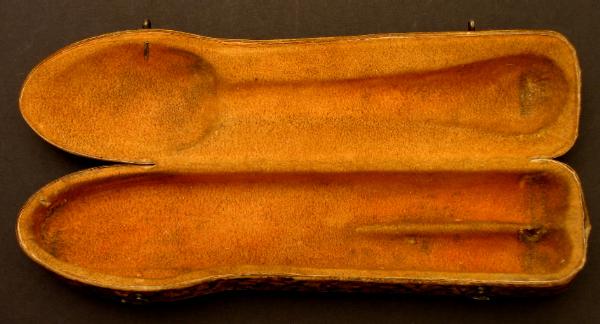
435
Extremely Rare Gold, Silver & Semi-Precious Stone Eating Set
Malay Peninsular, dated 1796
length of spoon: 19.6cm; length of box: 21cm
Boxed personal eating sets in the style of the example here were used by European gentlemen in the eighteenth century. They were part of a gentleman’s kit when he was travelling – the availability and cleanliness of local eating utensils while one was travelling was uncertain. At that stage using eating utensils was still largely reserved for European royalty and members of the aristocracy. Sometimes today, such sets are known somehwat erroneously as ‘picnic sets’
The handles of each of the fork, knife and spoon are in silver gilt over which extremely fine and intricate plain and beaded silver filigree and faceted spangles in the form of scrolling tendrils have been applied. The work is similar to the filigree and granule over-work applied to a gold eighteenth century tobacco box from the royal court in Terengganu in the collection of Malaysia’s Muzium Negara (E93.1971). The Museum estimates the box to be “about 200 years old.”
Each utensil terminates in a gold cap comprising three tiered rows of separately made gold stars or flowers that lead to a twisted gold wire coil topped by a faceted red coloured semi-precious stone. The cap is attached by means of a screw. Similar examples of such gold work can be seen in the gold disks sometimes applied to the tops of lids of more luxurious early Malay tobacco and betel boxes.
The remainder of the spoon and fork are in gilded silver; the remainder of the knife is in polished steel.
The fork has just three tines, which is typical of eighteenth English century forks. Forks with four tines are more typical of the nineteenth century and later. Similarly, the knife has a bulbous end which is typical of eighteenth century eating knives.
The back of the bowl of the spoon is engraved with a pheasant or possibly a phoenix surrounded by foliage and flowers. The flowers possibly have a Chinese appearances being reminiscent of stylised Chinese chrysanthemums. But overall, engraving to the back of the bowl of the spoon is in keeping with eighteenth century European practice for more elaborate eating sets. The bridge of the front of the bowl is similarly engraved with a floral design.
Importantly, each piece is engraved on a plain silver rim just below the gold wire terminals with the letters ‘JSH PB 1796’. The box is similarly stamped with the initials ‘JSH’, then ‘PB’ and ‘1796’. The box and the stamped date and initials all have considerable, obvious age.
The box in tooled, molded hide with a suede interior is decorated over much of its surface with impressed, coloured floral designs. The lid has a central cartouche with a green border within which are the remains of a scene that appears to include a European-style castle. The box holds all three utensils and is closed securely by means of two high-grade silver hooks and eyelets.
Whilst the eating set is made to European tastes, the work is clearly Malay, and with the dating which is inscribed to each pieces and confirmed by the embossed dating and initials on the box, probably represents the earliest known example of such Malay work that is actually dated.
Quite how this set came into being is open to conjecture. Possibly it was commissioned by early colonial visitors to the Malay peninsular. But then the standard of the work suggests courtly origins. Certainly, eighteenth century gold and silver smithing in the Malay sultanates was not a village craft – most artisans lived in or near the royal courts and were supported by the sultans. Perhaps the set was commissioned by one of the Malay courts as a gift or was commissioned by a Malay royal for personal use when in the presence of Europeans. At other times, Malay rulers, indeed all Malays, ate not with utensils but with the right hand.
References
The Terengganu tobacco box is illustrated in Muzium Negara,
Gold Jewelry and Ornaments of Malaysia,
1988.
Inventory no.: 435
SOLD






